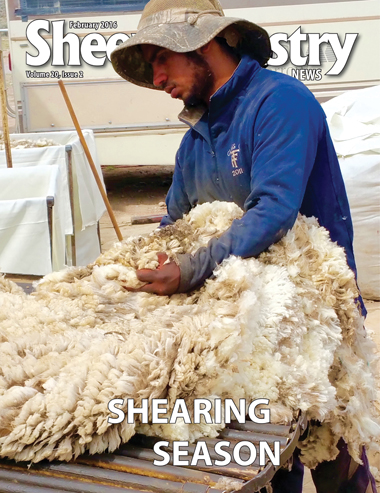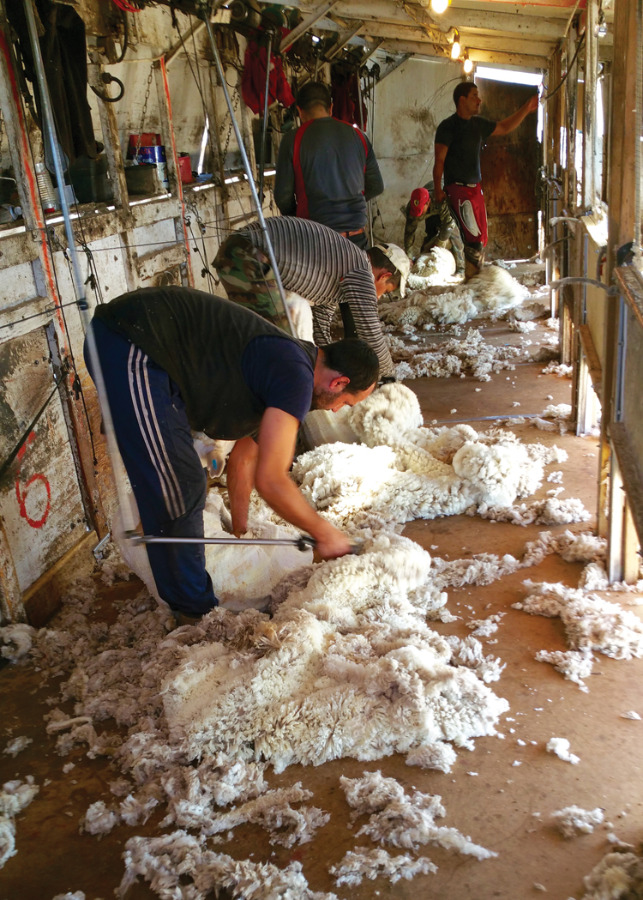
- February 2016
- President’s Notes
- Tips for Shearing Season
- Benny Cox is a Man of Many Hats
- Hiring Extra Farm/Ranch Help
- Sutton Ridge Adds Unique Twist to Shearing Day
- Wisconsin Station Discontinues Dairy Sheep Program
- Market Report
- Obituaries
- KENTWOOL Sponsors Pro Tour Caddies
- Shropshires Offer Starter Flock
- News in Brief
- The Last Word
Tips for Shearing Season
Sure you want a good wool clip. Everybody wants a good clip. But are you willing to put forth the effort needed to make it the best that it can be?
 Even the best shearers in the world can’t make the most of shearing day without a little help. In some cases, that means making sure you’re on the same page with your shearer and his crew long before they arrive on site. The larger the flock, the more planning and communication is key to making the day successful.
Even the best shearers in the world can’t make the most of shearing day without a little help. In some cases, that means making sure you’re on the same page with your shearer and his crew long before they arrive on site. The larger the flock, the more planning and communication is key to making the day successful.
ASI Wool Consultant Ron Cole, who regularly conducts wool classing schools for the association and works with shearing schools offers some things to think about as you prepare for one of the most labor-intensive days of the entire season.
• Have facilities ready and prepared for the shearing crew. This includes adequate pen space, working facilities, extra labor to move and sort sheep prior to shearing, as well as processing sheep after shearing. You might need to provide help and assistance moving wool bales or bags away from the shearing site to a storage facility.
Sort different wool types prior to shearing to reduce cross contamination. The preferred shearing order remains white face, crossbreds, black face and, lastly, hair sheep or hair sheep crosses.
• Sheep should be held off feed and water overnight prior to shearing. This eliminates fecal and urine contamination on the shearing floor and helps keep wool as clean as possible. It’s also easier for shearers to handle the sheep during shearing when this rule is followed.
• Visit with your shearer or shearing crew manager prior to shearing to determine what is to be accomplished at the shearing site: bellies out only, will wool be classed, perhaps skirted? Who is providing the packaging for the wool?
What type of packaging is needed? Burlap, film and nylon packs are all approved packaging materials in the U.S. Who will label the bales and keep the wool press record?
• Provide a trash bin on site for disposal of hair type fleeces, bloody wool, skin pieces, heavy tags or contamination items.
• If using a shearing crew, the producer should try to provide electrical outlets for campers, water, restrooms and showers for the crew.
• A hot meal at noon – provided by the grower – is sincerely appreciated by the shearing crew and makes a significant difference in the afternoon work performance of the crew. Mid-shift snacks at break time are also much appreciated by the crew and strengthens the relationship between the producer his crew.
• Respect for the producer and mutual respect for the shearing crew has to be gained by performance. It continues to be a team effort to make shearing day a positive experience for all involved.
• With fewer shearing crews available, as well as fewer shearers, both domestic and foreign, producers will find it beneficial to do everything possible to complete shearing day with minimal stress on the sheep, working help and shearing crew.
• Sheares also recommend that producers use plastic ear tags and place them in the sheep’s left ear, toward the outside edge approximately half way between the base and the tip. Metal ear tags are especially dangerous during shearing.
Remember, investing in the quality of your wool clip should pay for itself in the long run.
“Having a quality wool clip invites multiple buyers, and increased competition results in increased prices,” says ASI Wool Marketing Director Rita Kourlis Samuelson. “High prices for quality wool are out there. There are many high-quality, long-lasting, high-performance apparel products that need ‘white gold’ or quality wool. Better quality woolsare less expensive to process and produce a better yarn and textile product.”
Another way to enhance wool quality is proper harvesting techniques on shearing day. Proper preparation is always viewed with the processor in mind. The goal is to provide the processor with the most uniform product possible.
Effective sorting and classing methods and appropriate packing of wool are important components of the harvesting process. The industry is making progress in these areas, which includes pulling bellies and keeping contamination out of the clip. What has been key in this development is producers participating in educational programs offered by ASI. The association’s U.S. Certified Wool Programs for producers and shearers offers a set of standards for a self-regulatory approach to wool clip preparation for either a ranch or farm flock operation. In addition, certified classing and wool handling schools have been developed to help educate producers and wool handlers in areas that are vital to producing a quality wool clip.
When preparing for shearing day, at a minimum, consider the following first three steps below to optimize effectiveness and financial return. With a fine, white-face wool operation, the last two steps should additionally be considered.
• Minimize wool contamination.
• Sort sheep before shearing and package different types of wool separately.
• Remove belly wool and tags during shearing and package separately.
• Some wools benefit from table skirting to remove inferior wool.
• Class wool in like groups for commercial marketing purposes.
Taking precautions to produce a quality clip opens a plethora of marketing options for producers. In a softer market, buyers have the ability to be pickier with their purchases and will buy better prepared clips first.
So, if shearing day is on the horizon, now is the time to prepare for your best clip yet.

